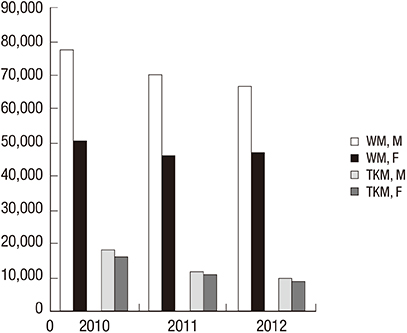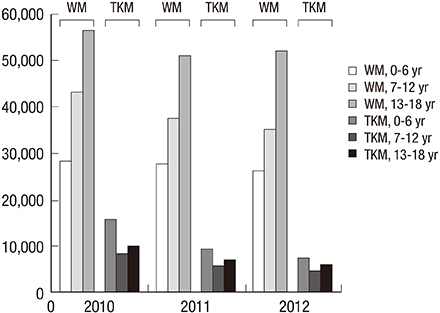J Korean Med Sci.
2016 May;31(5):770-776. 10.3346/jkms.2016.31.5.770.
Utilization of Western and Traditional Korean Medicine for Children and Adolescents with Mental Disorders: a Nationwide Population-based Study from 2010 to 2012
- Affiliations
-
- 1Department of Psychiatry, College of Medicine, Inje University, Sanggye Paik Hospital, Seoul, Korea. kimbs328@paik.ac.kr
- 2Department of Psychiatry, Chung-Ang University College of Medicine, Chung-Ang University Hospital, Seoul, Korea.
- 3Department of Psychiatry, Kyung Hee University School of Medicine, Seoul, Korea.
- KMID: 2373676
- DOI: http://doi.org/10.3346/jkms.2016.31.5.770
Abstract
- When in need of medical treatment, Korean citizens have a choice of practitioners of western medicine (WM) or Traditional Korean Medicine (TKM). However, the two branches frequently conflict with one another, particularly with regard to mental disorders. This study was designed to compare the utilization of WM and TKM, focusing on child/adolescent patients with mental disorders. We analyzed F-code (Mental and behavioral disorders) claims from the Korean Health Insurance Review and Assessment Service, including data from 0-18-year-old patients from 2010 to 2012. Slightly more men than women utilized WM, while TKM use was almost evenly balanced. WM claims increased with advancing age, whereas utilization of TKM was common for the 0-6 age group. In WM and TKM, the total number of claims relying on the National Health Insurance Service (NHIS) was 331,154 (92.78%) and 73,282 (97.85%), respectively, and the number of claims relying on medical aid was 25,753 (7.22%) and 1,610 (2.15%), respectively. The most frequent F-coded claim in WM was F90 (Hyperkinetic disorders), with 64,088 claims (17.96%), and that in TKM was F45 (Somatoform disorders), with 28,852 claims (38.52%). The prevalence of a single disorder without comorbidities was 168,764 (47.29%) in WM and 52,615 (70.25%) in TKM. From these data, we conclude that WM takes prevalence over TKM in cases of attention deficit/hyperactivity disorder (ADHD), as well as in psychological problems such as depression and anxiety. On the other hand, patients utilizing TKM more commonly present with physical health problems including somatoform problems, sleep, and eating disorders.
MeSH Terms
-
Adolescent
Attention Deficit Disorder with Hyperactivity/epidemiology/therapy
Child
Child, Preschool
*Cognitive Therapy
Databases, Factual
Demography
Female
Humans
Incidence
Infant
Infant, Newborn
Insurance Claim Reporting
Male
*Medicine, Korean Traditional
Mental Disorders/epidemiology/*therapy
Republic of Korea
Social Class
Figure
Reference
-
1. Ahn DH. Mental disorders in adolescents. J Korean Med Assoc. 2009; 52:745–757.2. Kim SY, Erm T, Park S, Hong JP, Han OS, Yoo HK. Education, clinical practice, and research on psychiatric illnesses in Korean traditional medicine. J Korean Neuropsychiatr Assoc. 2007; 46:151–158.3. Sadock BJ, Sadock VA, Ruiz P. Kaplan and Sadock's Synopsis of Psychiatry: Behavioral Sciences/Clinical Psychiatry. 11th ed. Philadelphia, PA: Wolters Kluwer;2014.4. Kim M, Han HR, Kim KB, Duong DN. The use of traditional and western medicine among Korean American elderly. J Community Health. 2002; 27:109–120.5. Hong K. Korean child and adolescent psychiatry: a review of the past, the present and the future. J Child Adolesc Psychiatry. 2003; 14:139–149.6. The Korean Society of Oriental Neuropsychiatry. accessed on 1 September 2015. Available at http://www.onp.or.kr.7. Statistics Korea. Korean Standard Classification of Disease (KCD), 6th ver. accessed on 6 July 2010. Available athttp://kostat.go.kr.8. Kim L, Kim JA, Kim S. A guide for the utilization of Health Insurance Review and Assessment Service National Patient Samples. Epidemiol Health. 2014; 36:e2014008.9. Choi SM, Park GM, Shin MK, Shin HK. The research on the disease classification of the traditional medicine in Korea. Korean J Orient Prev Med. 2000; 4:93–107.10. Krajewski C, Burazeri G, Brand H. Self-stigma, perceived discrimination and empowerment among people with a mental illness in six countries: Pan European stigma study. Psychiatry Res. 2013; 210:1136–1146.11. Park JE, Cho SJ, Lee JY, Sohn JH, Seong SJ, Suk HW, Cho MJ. Impact of stigma on use of mental health services by elderly Koreans. Soc Psychiatry Psychiatr Epidemiol. 2015; 50:757–766.12. de Girolamo G, Dagani J, Purcell R, Cocchi A, McGorry PD. Age of onset of mental disorders and use of mental health services: needs, opportunities and obstacles. Epidemiol Psychiatr Sci. 2012; 21:47–57.13. Jung KH, Ahn DH, Kim JY, Kim HJ, Bang YW. A practice patterns of child and adolescent psychiatrists in South Korea. J Korean Acad Child Adolesc Psychiatry. 2014; 25:6–13.14. Woo JM, Son MH, Kim GM, Chae KC. Future of clinical practice in psychiatry. J Korean Neuropsychiatr Assoc. 2014; 53:144–153.15. Jang JS, Hwang WW, Cho SH. The current status and medical fee propriety of psychotherapy and neuropsychological test for dementia in Korean medicine. J Orient Neuropsychiatry. 2014; 25:411–421.16. Lee H, Hwang ST. Clinical study of child and adolescent pyschiatric outpatients. J Child Adolesc Psychiatry. 1996; 7:14–22.17. Eun KS, Ryu SY, Jung CH. Distributional change of child and adolescent psychiatric outpatients at a university hospital in Daegu. J Korean Soc Biol Ther Psychiatry. 2005; 11:78–88.18. Park J, Chung I. Adolescent suicide triggered by problems at school in Korea: analyses focusing on depression, suicidal ideation, plan, and attempts as four dimensions of suicide. Child Indic Res. 2014; 7:75–88.19. Ahn SY, Baek HJ. Academic achievement-oriented society and its relationship to the psychological well-being of Korean adolescents. In : Yi C, editor. The Psychological Well-Being of East Asian Youth: 2 (Quality of Life in Asia). Dordrecht: Springer;2013. p. 265–279.20. Bhang SY, Yoo HK, Kim JH, Kim B, Lee YS, Ahn D, Suh DS, Cho SC, Hwang JW, Bahn GH. Victims of bullying among Korean adolescents: prevalence and association with psychopathology evaluated using the adolescent mental health and problem behavior screening questionnaire-II standardization study data. J Korean Acad Child Adolesc Psychiatry. 2012; 23:23–30.21. Son MJ, Han JK, Kim YH. A clinical study of the children and adolescents inpatients admitted to the oriental medical hospital. J Korean Orient Pediatr. 2011; 25:55–72.22. Kim JW. Mood disorder. In : Hong KE, editor. Korean Textbook of Child Psychiatry. Seoul: Hakjisa;2014. p. 233–252.23. Petit D, Touchette E, Tremblay RE, Boivin M, Montplaisir J. Dyssomnias and parasomnias in early childhood. Pediatrics. 2007; 119:e1016–25.24. Mohapatra S, Deo SJ, Satapathy A, Rath N. Somatoform disorders in children and adolescents. Ger J Psychiatry. 2014; 17:19–24.25. Choi BY, Park JU, Jung IC, Lee SR. A clinical study and an analysis of symptom check list-90-revision on psychiatric patients visiting the emergency room in an oriental medicine hospital. J Orient Neuropsychiatry. 2003; 14:155–167.26. Kim JW, Shin HK, Chu CN, Lee JW, Park SJ, Kim KH, Seo JH. A clinical study on outpatients in oriental neuropsychiatry clinic of an oriental medicine hospital. J Orient Neuropsychiatry. 2007; 18:123–134.27. Lee GE, Park JH, Lyu YS, No DJ, Park IS, Kang HW. A study on difference of somatization psychological mechanism among Sasang Constitution (Four type Constitution). J Orient Neuropsychiatry. 2011; 22:23–42.
- Full Text Links
- Actions
-
Cited
- CITED
-
- Close
- Share
- Similar articles
-
- Estimation of Attributable Risk and Direct Medical and Non-Medical Costs of Major Mental Disorders Associated With Air Pollution Exposures Among Children and Adolescents in the Republic of Korea, 2011–2019
- Mental Disorders in Adolescents
- The promotion of mental health and the prevention of mental health problems in child and adolescent
- Recent statistics and risk factors of suicide in children and adolescents
- Respiratory Health, Sleep Dysfunction, and Mental Health in Children and Adolescents With a Neuromuscular Disorder: A Descriptive Qualitative Study



